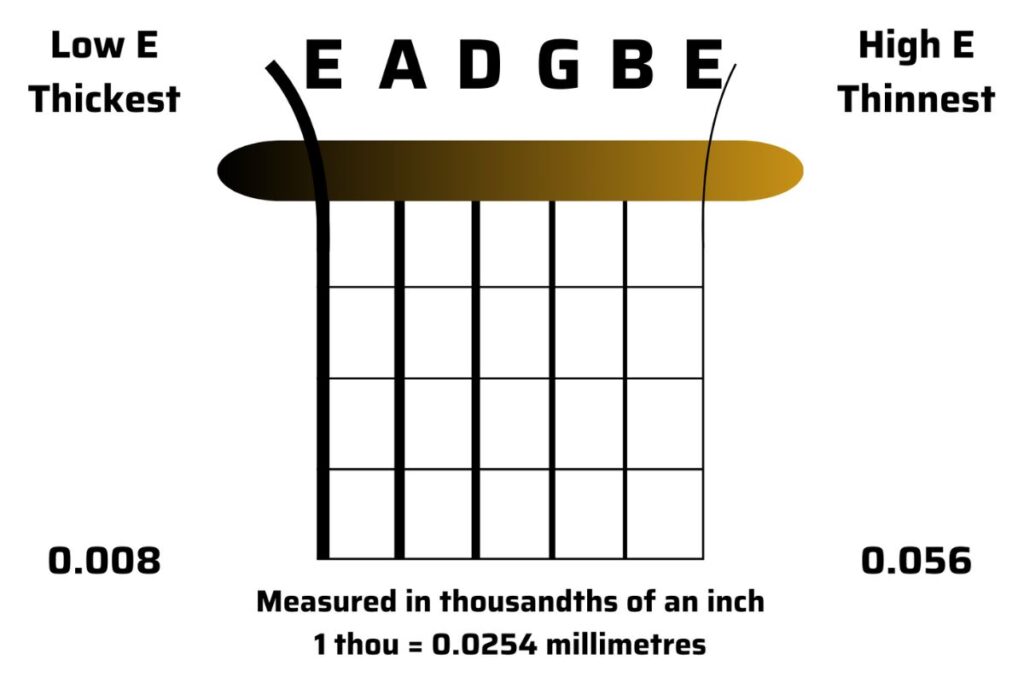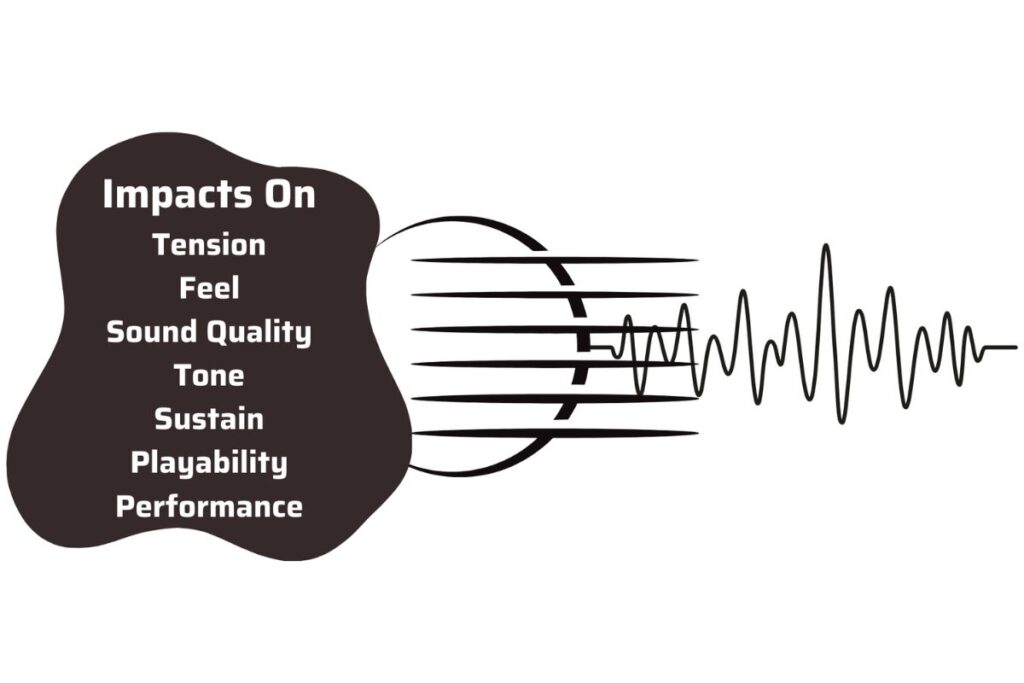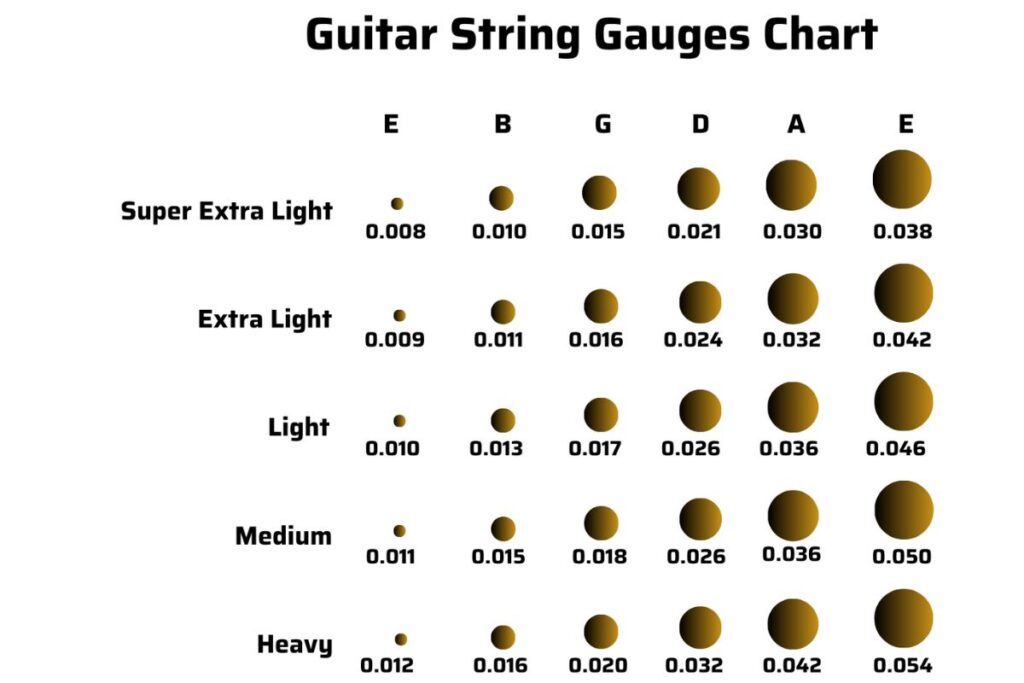Guitar String Gauges Chart

Each string of the guitar has a different voice.
When you strum them all together, the “tttrriing….” sound takes you to a different zone. It’s all because of the melodic tone the instrument offers.
The quality of such tone depends on two factors–
- Material
- Thickness
The latter is what the guitar string gauge is. It’s the measurement that tells how thick or thin the string is. This influences all the properties of the guitar.
It includes–
- Tone
- Playability
- Overall performance
Because of such changes, you must understand this part of the guitar.
That way, you can pick one that matches your style– skill– and expertise.
Key Takeaways: Guitar String Gauges Chart
- Refers to the thickness of strings
- Measured in thousandths of an inch
- Thicker strings offer rich, warmer tones but are hard to strum
- Thinner strings offer a brighter tone and are easier to strum
- Consider factors like playing styles, guitar type, and playability before buying
- Nickel and stainless steel are the most common materials
What Are Guitar String Gauges?

They refer to how thick or heavy the wire is. If we define it–
Guitar String Gauges quantify the diameter, thickness, or weight of the wire material in a guitar.
You can measure them in thousandths of an inch. They can also be measured in millimeters. Just multiply the thousandth number by 25.4 to convert 1 thousandth of an inch to millimeters.
The thickness often ranges from 0.008 to 0.056 more or less.
For example—
- A string with .008 gauge has a diameter of 0.008 inches. This represents ultralight.
- A string with .056 gauge has a diameter of 0.056 inches. This represents super heavy.
All the instruments come with strings set of different thicknesses. The standard tuning of the set goes like this— EADGBE.
Among them–
- The thinnest or lightest one means the 1st string i.e. high E.
- The thickest or heaviest means the 6th or 12th string i.e. low E.
Guitars usually label the range of the thinnest and the thickest strings within the set. The other strings also have varying gauges. However, the range gives you an idea of the overall diameter of the string.
Both light and heavy gauge strings have individual strengths and weaknesses.
Why Do Guitar String Gauges Matter?

Such a measurement plays a key role in the instrument. It influences tension, feel, and sound quality. This further impacts your guitar’s tone, sustain, playability, and overall performance.
Even studies say the same.
You may find the gauge difference minuscule, but it can transform a lot of things.
Tone
A thicker string gauge produces a fuller, warmer tone. It gives you more volume and sustains.
In case you like something rich and deep, try out guitars with heavy gauges.
Thinner strings give a brighter, treble-heavy sound. The mids and lows will be controlled.
To know more about tone, explore tonewood!
Playability
Lighter gauge strings let you press them down with ease. It’s perfect for players who are either new or have finger sensitivity.
Contrariwise, heavier gauge strings are difficult to strum. They are great for those who want stronger attacks or more control.
Tuning Stability
If you play in drop tunings or alternative, a thicker gauge works better. Such strings hold tension more properly. This eventually helps keep your guitar in tune.
Thinner or lighter ones can be less stable. However, if the tuning is standard, they can stay in tune and maintain enough tension to hold their pitch.
Durability
Thicker strings are naturally more durable. They won’t break easily no matter how aggressively you strum.
This is because such parts have more material to absorb impact and withstand many issues. Hence, they won’t get damaged soon.
If you’re a hard-hitting player, such strings will be perfect.
On the other hand, thinner ones break easily. They can’t withstand pressure much. In fact, the strings are great for soft strumming or country playing.
Common Materials Used In Guitar Strings
| Material | Properties | Use | Gauge |
| Nickel-plated Steel | Bright, balanced tone; durable | Electric and acoustic guitars | Extra Light, Light, Medium, Heavy |
| Stainless Steel | Bright sound; corrosion-resistant | Electric and acoustic guitars | Extra Light, Light, Medium, Heavy |
| Phosphor Bronze | Warm, rich sound; good sustain | Acoustic | Light, Custom Light, Medium |
| 80/20 Bronze | Bright tone; strong initial attack | Acoustic | Light, Medium |
Understanding the Guitar String Gauge Chart

String Gauge Categories
| String Gauge | Thickness | Playability | Bright/Warm |
| Super Extra Light | .008 – .038 | Highest | Highly crisp |
| Extra Light | .009 – .042 | Higher | Brighter |
| Light | .010 – .046 | High | Bright and warm |
| Medium | .011 – .050 | Low | Warmer |
| Heavy | .012 – .054 | Very low | Warmest |
Super Extra Light (.008 – .038)
Call them the thinnest guitar string gauge. It ranges between .008 and .038.
Such guitars are easiest to play as the wires are super flexible and bendy. This means you don’t need much pressure to press down the strings.
The flex and ease of strumming make it quite suitable for beginners and players with sensitive fingers.
Thinner strings mainly give you a brighter and crisper tone. They lack some depth so the mids and lows will be tight.
Few guitars use such thinner strings. For instance- Zager offers the lightest strings for newer players.
Music Genres: Pop, rock, blues, and funk.
Playing Styles: Strumming and intricate playing.
Advantages
- Super easy to play
- Highly flexible
- Brighter tone
- For beginners and players with weak hands
Disadvantages
- More prone to breaking.
- Sounds a bit too thin.
Extra Light (.009 – .042)
Slightly thicker than the previous ones.
Yet, they are so thin that you’ll barely notice the difference. Then again, the strings will be more durable.
Extra light strings measure between .009 and .042.
Such guitars will be quite easy to play. They offer slightly more tone and sustain than super extra lights.
You still get a bright and crisp tone from the guitars, although a little more balanced. This makes them pretty versatile.
Since these strings are also easy to bend, you can enjoy quick finger movement from the instrument.
Music Genres: Rock, country, and folk
Playing Styles: Fingerstyle and strumming
Advantages
- Quite easy to play
- Very flexible
- Versatile
- Richer tone
Disadvantages
- Less volume
- Tuning instability
Light (.010 – .046)
A well-balanced measurement between thin and thick. Such strings feel pretty soft on hands. The thickness of the light string gauge falls in the .010 to .046 range.
Most guitars have these strings. They are quite popular among players since they offer both playability and tone.
However, the guitar may still need a little pressure on the strings to strum. Then again, as you practice, this won’t feel heavy. Instead, you’ll get to enjoy its ease of flexibility.
Guitars with light strings have more volume and resonance. They give you a fuller and richer sound. The strings maintain a bit of brightness but with more body.
Because of this function, the guitar can easily handle a range of playing styles. They can offer enough tension for clear strumming or picking.
Music Genres: Rock, blues, and jazz
Playing Styles: Clear strumming, fingerpicking, and lead playing
Advantages
- Great balance of playability and tone
- Offers a rich tone and resonance
- Balanced feel
- Suitable for many styles of playing.
Disadvantages
- Moderate tension
- Not for players with weak fingers
Medium (.011 – .050)
Definitely thicker. So you’ll need more finger strength to press down the strings and bend them.
Medium string gauges measure around .011 to .050.
They produce a fuller, richer tone. You get a nice warmer and deeper sound. Plus, it gives you higher volume, resonance, and sustain.
Guitars of such kinds are perfect for players who want a more body vibe in the tone.
Because the strings will be tougher to bend, we don’t suggest them for beginners. They are rather suitable for intermediate and advanced players.
That said, if you have high finger strength, you can still consider strumming them.
Music Genres: Jazz, fingerstyle, and classical
Playing Styles: Fingerstyle, rhythm playing, and intimate solos
Advantages
- Balanced
- Full, rich tone
- Greater sustain
- Warmer and deeper
Disadvantages
- Difficult to strum
- May require some setups
Heavy (.012 – .054)
The thickest which means the hardest to play.
Heavy gauge strings range from .012 to .054.
Because of their thickness, you’ll need lots of power and finger strength to strum.
A bit turnoff but this drawback provides multiple benefits. For instance— louder volume and rich sound.
Guitars with thicker strings bring out a very warm and powerful tone. They have a higher sustain plus the tuning stability is incredible. So, you can enjoy them more properly.
If you want rich low-end tones, they can be the best.
However, since these strings are difficult to bend, they are better for experienced and advanced guitarists.
Music Genres: Hard rock, heavy metal, and fusion
Playing Styles: Slide guitar and drop tunings
Advantages
- Improved tuning stability
- A richer and louder tone
- Warmest and deepest
- Higher sustain
Disadvantages
- Very hard to strum the instrument
- Risk of neck damage
- Did heavy strings cause ache? Check out tips from this blog to ease finger pain.
4 Factors to Consider When Choosing Guitar String Gauges

1. Playing Style
It surely plays a key role here.
The style you have can influence which guitar string gauge works best. For playing styles like– soft fingerpicking, gentle strumming, or intimate solos, thicker strings would be super suitable.
Heavy gauge strings produce a warmer, fuller tone. This can complement delicate playing.
Thinner or lighter gauge strings are great for aggressive strumming, tapping, slapping, or fast lead playing.
The strings produce a brighter tone. Combining that sound with ease of playability lets you play faster and more dynamically.
2. Tuning Preferences
String gauge also matters when it comes to your tuning.
If you play in standard tuning i.e. EADGBE, opt for lighter gauges like .008s or .010s. They can hold tension well and are easier to bend. You’ll enjoy a brighter tone from such strings. These make it ideal for regular tunings.
For drop tunings i.e. DADGBE or alternate tunings, heavier gauges like .054s work great. They can maintain extra tension that helps keep the sound strong and stable. Plus, you’ll relish a fuller and warmer tone.
3. Finger Strength and Dexterity
Your finger strength and comfort level have an impact too.
As we all know, thicker strings are tougher to bend. Your hands and fingers need to be super strong to strum them. Unless you’re that kind of person, it’s better to opt for lighter ones.
Heavy gauge strings work better for more advanced and pro players. It’s because they’re used to it.
To enjoy the ease of playability, try out the lightest string gauge like Zager Guitar. They weigh below 0.008 so you can effortlessly bend and play the instrument.
Because of their thinness, most beginners and players with weak fingers or arthritis issues opt for it.
4. Genre and Sound
Different genres come with distinct tone requirements.
You need a warm, resonant tone for folk, acoustic, soft rock, and blues. This is what thicker or heavier gauge strings provide.
Let’s say you play rock, pop, funk, or country. In that case, lighter strings will suit the fast rhythm and lead playing. It’s because they generate a bright, sharp tone.
How to Use the Guitar String Gauge Chart?

Matching Your Preferences with the Chart
Step 1: What’s Your Guitar Type?
Do you have an electric or acoustic guitar? Different guitars use different string gauges.
This will help narrow down your options. For instance–
- Electric guitars: They have a solid body or a semi-hollow design. Such guitars use magnetic pickups.
Common gauges for electric guitars are between .009 and .011.
- Acoustic guitars: They usually have a hollow body and the tonewood feels solid.
Such guitars use gauges ranging from 0.008 to 0.054 to more.
Step 2: Understand The Numbers
You measure the gauges in thousandths of an inch. For example—
A .008 gauge string, the one used in Zager, is 0.008 inches thick.
Get to know these numbers. Each string in the set weighs differently and produces a different feel— tone— volume.
Step 3: Determine Your Playing Style
First, know what’s your style. Is it—
- Heavy strumming?
- Light fingerpicking?
- Something in between?
Lighter strings are great for easy bending techniques like strumming and aggressive fingerpicking. Meanwhile, heavier strings are great for gentle strumming and fingerstyle.
Step 4: Experiment With Different Gauges
Once you’ve selected a gauge, try it out on your guitar.
Focus on–
- How they sound
- How they feel under your fingers
It’s okay if they don’t feel right.
Revisit the chart and try another gauge.
How Often Should You Change Your Guitar Strings?
Strings have a shelf life. They can wear out based on the quality, material, thickness, and how often you use them.
A lot of things deteriorate the strings and distort the tone–
- Grime
- Sweat
- Use frequency
- Aggressive strumming
- Water
- External elements
Hence, we suggest replacing your guitars. For instance–
Light Gauge Strings
Replace every 2-4 weeks.
Thinner strings wear out quickly. Plus, they lose their brightness and elasticity easily.
Medium Gauge Strings
Change every 3-5 weeks.
Mid-range strings offer a balance between playability and durability. However, they can still lose tone because of sweat, dirt, and oils coming out of your fingers.
Heavy Gauge Strings
It lasts 4-6 weeks.
So change when they sound different, feel stiff you notice a loss in tone.
Heavy strings can get damaged too. You can blame– frequent use, abuse, age, grime, and sweat.
Popular Brands and Their String Gauges
1. Zager Strings
Zager guitar– you may know us by the one who offers playability.
This benefit comes from the use of the lightest guitar string gauge. Our strings come in high-quality soft nickel material, unlike most guitars that use stainless steel.
Such a change gives our guitar a melodious and versatile tone. Since the strings are the thinnest, you can easily play and strum our instrument.
We’ve designed them particularly for beginners.
Besides, many pro guitarists have loved our strings.
For example–
- Johnny Cash guitarist Dave Roe
- Celine Dion’s Lead Guitarist Andre Coutu
- Chet Atkins guitarist Pat Bergeson
The thickness of our guitar string gauges ranges from 0.008 to 0.048 based on the model.
| You can try our guitars like– → Zager ZAD900 → Zager ZAD80 → Zager ZAD20 |
2. D’Addario
They are quite famous for guitar strings.
D’Addario boasts a wide range of options for both electric and acoustic guitars.
Their strings give you incredible sound and durability. The wires are made of quality nickel-plated steel. Because such material combos bring out different tones, you can enjoy versatility.
One big benefit is that the company comes with varying gauges. So you can find what fits your style best.
Let’s give you the list here–
- Extra Light 10-47
- Custom Light 11-52
- Light 12-53
- Light Top/Medium Bottom 12-56
- Medium 13-56
- Heavy 14-59
3. Ernie Ball
Popular for its Slinky strings.
A lot of pop and rock guitarists use them for different music styles.
For instance–
Paul McCartney, Eric Clapton, and Keith Richards– all have played Ernie Ball strings to rock the stage.
Two of their common gauges are–
- Regular Slinky 0.010-0.046
- Power Slinky 0.011-0.048
Such strings have earned love for their bright sound and flexibility. They are both easy to play and offer a quality tone. Plus, the materials are solid.
Speaking of which, Ernie Ball uses premium material to construct strings. These include–
- Nickel
- Cobalt
- Maraging steel
- Stainless steel
- Titanium
4. Elixir
Well-known for their coated strings.
Elixir adds magic to their string through high-quality materials. Some are 80/20 bronze, some are phosphor bronze, and some are nickel-plated steel.
You’ll find them long-lasting and resistant to corrosion.
They come with different gauge options. Let’s highlight two common ones—
- Optiweb 0.010-0.046 for acoustic
- Polyweb 0.011-0.052 for electric
The coating, especially the nickel on Elixir strings maintains the natural tone.
You get a smoother feel and enjoy reduced finger noise.
Guitar String Gauge: Frequently Asked Questions
The Extra Light One.
Experts like Zager suggest using strings that are at least .009 to .011 for electric guitars.
They’ll leave some signs. Check these symptoms that tell you it’s time to change the guitar strings–
• Dull sound
• Rough feel
• Wear and tear
• Rust
• Discoloration
Yes, they do.
Heavier gauge strings can give you incredible tuning stability. It’s because they have increased tension.
Yes, you can mix string gauges.
However, it may require adjustments to your guitar’s setup to get optimal playability.
A heavier gauge, such as .012 to .054, is recommended for Drop D tuning to maintain tension and tone.
Light vs. Heavy Gauges: Which One Should You Choose?
Want to achieve the desired sound and playability? Then, you must explore and understand the concept of guitar string gauges. They affect both the tone and flexibility of the strings.
Each string in the set comes with a unique tone and tension. So, pick the right combination of gauges to enhance your experience.
If you want something bright and easy to play, then choose a light gauge.
For warmer tones, opt for heavier gauges. Just remember, it can be hard to play.
